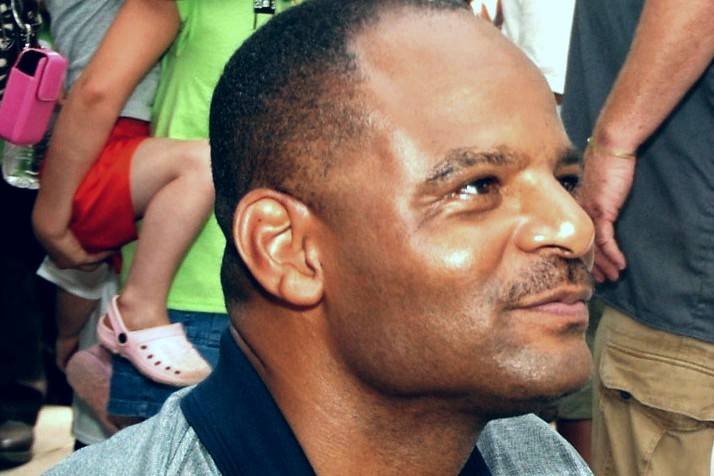ANTONIO DUNSMORE was in a tight spot. Illuminated at night by the headlamps and spotlights of a half-dozen Seattle police cars, he stood backed up to a wall at Garfield Community Center. Eight Seattle police officers, guns drawn, safely hidden behind their blue-and-whites 20 feet away, shouted orders. “Hands over your head! On the ground!” Dunsmore didn’t seem to understand. Decked out in an odd array— T-shirt, ski gloves and sunglasses—at one o’clock in the chilly morning, Dunsmore had been reported acting in an erratic and threatening manner. At the moment, he was making stabbing motions at the ground with a tiny knife and squinting into the lights.
With no other way out, a betting man might flop down and assume the position. But the sky was a different color in Antonio Dunsmore’s world. Unemployed, he lived off a state mental disability payment, and at age 31 was still being watched over by his Filipino mother. The dramas in his mind left Lourdes Dunsmore’s boy sometimes talking to himself, gesturing excitedly, disconnected from his surroundings—facts unknown to the anxious cops.
Then: “I saw the weapon. I saw the butt of the gun,” officer Erik Warner would recall later. “He pulled something out of his pocket, which was the gun.”
Police say Dunsmore took a shooter’s stance. Officers were protected by their cars, the area was sealed off, and a police negotiator was on the way. “He was probably blinded by the bright spot lights” as well, says Dunsmore family attorney Nolan Wright.
But someone opened fire anyway.
It wasn’t Dunsmore. Like his little knife, his gun, a clear plastic water pistol with multicolored innards, was a toy.
Officers say they thought it was a silver semiautomatic. In a blink, one began shooting, then another, then all eight. Chaos and sizzling bullets rained down. Within seconds, the cops had fired 25 shots. Dunsmore was hit at least 19 times. He fell backwards, limbs splayed, driven by the shots that splattered his blood in the hard white beams. As the gunsmoke drifted off, he lay perforated with 28 entrance and exit wounds.
Antonio Dunsmore was so dead that early April morning in 1995 that, his mother says, police didn’t bother with first aid or attempt to revive him.
But then, it was Dunsmore’s fault he got killed.
A six-member King County coroner’s inquest jury would unanimously find the cop fusillade “unnecessary, but justified”—a fatal kind of catch-22: Dunsmore shouldn’t have been killed, but it wasn’t wrong for police to kill him. In effect, the jury concluded Antonio Dunsmore’s wrongful actions got him rightly blown away.
That was the finding an inquest jury made a year later, as well, after Edward Anderson, 28, was shot to death point-blank, on his back, surrendering, in a Central District backyard. A Seattle officer said his gun went off accidentally. Even at that, Anderson, as a fleeing domestic violence suspect, had put himself in harm’s way, the jury thought.
Justified was also the finding in September this year for a King County sheriff’s sniper who killed Shoreline-area crime-spree suspect Lonnie Davis, 21. It was the finding in April when Seattle officers were excused for the death of Michael Ealy, 35, who died from a struggle with police and ambulance attendants.
All of the above, like all those killed by Seattle police in the past five years, were minorities, whose death-by-police toll is dramatically disproportionate to Seattle’s minority population. But color of skin is not the most common aspect of such killings. The end result is.
Justified, it turns out, is always the finding of a King County inquest jury, regardless of the victim’s race, sex, age, or even level of guilt or innocence. Despite the widely varying circumstances of each case, some form of justifiable homicide has been the outcome of every King County District Court inquest in modern memory, save for a few ending without findings of any sort.
“Justified,” says longtime Seattle criminal defense attorney Lem Howell, summing up the results. “But not justice.”
IMPANELED TO HEAR the facts, but few of the extenuating circumstances, of deaths involving law enforcement officers, inquest juries are required to render only answers to a series of questions about the death; to wit, how it happened and who may have caused it. The public may think of an inquest jury as a grand jury, says Mark Larson, chief deputy in the King County Prosecutor’s Office criminal division. But inquests are “designed to satisfy the public’s right to know, not to indict or decide guilt,” he notes.
His oft-times opponent Howell, who has represented families in a dozen county inquests, agrees somewhat, noting homicide inquests “perform the service of a public airing of the circumstances of death. When Edward Anderson was shot, his feet were hung up in a fence and a cop pointed a gun 12 inches from his Adam’s apple and shot him, quote unquote, accidentally. That came out at the inquest. It was important to have it on the record.” But Howell seriously questions the fairness of such hearings and, in the view of defense attorney Allen Ressler, also an inquest veteran, the inquiries “serve no useful purpose whatsoever. Most often the verdict is meaningless.”
For sure they’re predictable. In the past 20 years, never has any of an estimated 75 advisory inquest verdicts—even on the exceptionally rare occasion a jury is critical of officer conduct—led to the charging of a law enforcement officer in King County by 21-year prosecutor Norm Maleng, according to interviews and public documents.
Yet the county and local governments face more than $17.5 million in damage claims by families of victims who didn’t buy the “justified” inquest outcome. King County and suburban cities have paid more than $1 million in legal settlements to victims’ families in the past 10 years, according to records obtained by Seattle Weekly. The payments include a paltry $7,500 to the mother of toy gun-wielder Dunsmore, but $322,500 to the mother of Brian Hull, 21, who died of a burst appendix in the King County jail in 1990, and $150,000 paid to the family of Samuel Johnson, 41, shot in the back of the neck by an Auburn cop in 1989.
The county, having recently lost a partial summary judgment ruling, is now in talks to possibly settle the biggest police-shooting claim in its history, up to $10 million, with the family of James Wren, 35. He was murdered in 1996 by King County sheriff’s sergeant Mathias Bachmeier in an insurance fraud scheme. The sergeant was charged directly and no inquest was held. But Wren’s attorneys say an inquest jury 11 years ago allowed Bachmeier to get away with another murder: the shooting of Guadalupe Rios, 32, of Renton. An inquest jury found that shooting justified—self defense—though witnesses unheard by the jury have since suggested Bachmeier planted Rios’ gun.
Now doing life without parole for the Wren slaying, Bachmeier, 50, nonetheless is getting $2,500 in monthly state law enforcement disability retirement benefits, having successfully claimed that, regardless of his imprisonment, he couldn’t return to duty due to depression and post-traumatic stress disorder. It’s perfectly legal, says the state, but the Wren family is seeking to attach the benefits as part of their claim.
CRITICS SAY THE lawsuits and settlement payments suggest that if families can repeatedly obtain wrongful death compensation despite justifiable homicide findings, a more aggressive Maleng’s office could be filing criminal charges on the same evidence. That hasn’t happened, however. “Regardless of what the inquest jury does,” says attorney Ressler, “neither the police nor the prosecutor are bound by their results.”
That means the cops can sue, too, as two Seattle officers are today. After Michael Ealy’s mother filed a wrongful death suit against them and the city in July, officers Thomas McLaughlin and Richard Traverso (found justified in the controversial restraint death case) recently countersued Ophelia Ealy for $1,000 each, calling her lawsuit an “injury” to them and a “conspiracy to misuse judicial process.”
“They’re the ones who [allegedly] killed her son,” says Ealy’s attorney, Howell. “Now they’re suing her. It’s ludicrous.” (In their countersuit, the two officers deny direct responsibility for Ealy’s death.)
Howell and other critics think the exculpating inquest system—which appears to align police and prosecutor, as usual, on the same side—makes it easier for prosecutors to avoid the tough calls afterward. Of the 30 officer-related deaths since 1980 involving the Seattle Police Department, for example (28 were shot, two died resisting arrest), none of the officers involved were charged with criminal acts.
The deaths include, besides the Dunsmore and Anderson “accidents,” the 1988 shootings of Erdman Bascom, 42, and William Tucker, 44, also African Americans. Tucker was shot in the chest while surrendering during a drug raid at his Central District home. Bascom, startled as police broke into his nephew’s Rainier Valley apartment on a drug raid (no drugs were found), was instantly shot to death as he rose from his couch, pointing with a TV remote in his hand. Those also were deemed accidental.
Though an ongoing Seattle police internal investigations scandal has prompted new attempts toward public accountability, cop-related killings and the inquest system are the source of far more community anger and concern for some, especially minorities. African Americans have long been screaming about systemic inquest unfairness as one after another exculpatory finding is cranked out. Of the 30 who died at Seattle police hands since 1980, 17 were white and 13 were minorities. Nine, just under 30 percent of those slain, were African Americans, who compose less than 11 percent of Seattle’s population. In the past five years, all five who died were minorities—four black, one Filipino.
“That’s all?” says a skeptical Howell, 63, who has been involved in inquest hearings since 1971, when black militant Larry Ward was killed by police (justified) after planting a bomb at a Jewish business in the Central District. “I thought it was more [minorities killed]. It seems like it, anyway.”
THE BELIEF THAT prejudice is behind some of the shootings gets a lot of currency in the black community. “There’s a perception,” says activist Harriett Walden, from Mothers for Police Accountability, “that there’s a lesser penalty, if any, for killing a black man.” The question most often asked is: Would he have been killed if he was white? Would, for example, the dark-skinned Antonio Dunsmore have been obliterated by police bullets if he was a white man cornered outside the Magnolia Community Center?
To blacks and supporters, the answer seems obvious. After an inquest jury justified Michael Ealy’s death, cousin Andre Roberts said, simply, “Cops can kill African Americans.” Jerry Hudson, brother of Antonio Jackson, killed in a 1993 Federal Way struggle with county officers and Safeway employees after an alleged shoplifting incident, was outraged no charges were filed. “If the victim was white, it would be a totally different outcome,” he said. Jackson’s attorney, Ressler, who is white, claims the prosecutor’s decision not to file charges would have been “much different if a white lawyer got choked to death by a black man.”
Even seemingly justified shootings such as the 1996 Seattle police shooting of 84-year-old African American Bodegard Mitchell, who had wounded a housing worker and a police officer before he was killed, raise racial suspicions. Ironically, that case and later developments led to the current SPD conduct reform efforts, after a white now-retired detective, Sonny Davis, was accused of taking more than $10,000 from the Mitchell crime scene (Davis’ first trial ended with a hung jury). Police and prosecutors see no racial aspects to the case, but the first group to demand a retrial was the Seattle NAACP chapter.
Devaughn Dorsey, 25, the black cousin of point-blank shooting victim Edward Anderson—and a friend of Safeway choking victim Antonio Jackson—claims he’s in King County jail today due indirectly to the supposed carte blanche given cops by inquest juries. Police say Dorsey is a chronic reoffender (convicted of drug, assault, and gun possession charges) and liar. But he claims that after filing an internal complaint over police harassment, a cop promised, “I’ll arrange for the same thing that happened to your relative to happen to you.” He has now filed a civil rights suit against the city.
WHEN WE ASKED King County Executive Ron Sims about the inquest process, he thought we had some “good questions.” But Sims, who is African American and the person responsible for calling inquests, chose not to respond. Likewise, a handful of County Council members responding to Weekly inquiries expressed interest in studying the issue further. But there are no plans to change the current system, which has been in effect since the 1980s, after the old coroner’s office was phased out. The medical examiner’s office took over the elected coroner’s duties except for one: the inquest, which was put in the hands of the elected executive (see “How Inquests Work,” page 27). Elected in 1997, Sims, along with his predecessors including now-Governor Gary Locke, have been kept busy calling inquests—on average one every three months in the past decade.
Figures available since 1990 show the King County Sheriff’s Department has been involved in eight deaths, five of them shootings. County jail custody officers were also involved in eight deaths, most ruled suicides. State troopers and suburban city police and jail officers were involved in 17 King County deaths. An inquest was also held in the 1998 suicide of a teenage girl at Echo Glen juvenile facility, where officials were accused of abusing her; a jury found the staff blameless.
Altogether, in the past 10 years, more than 40 countywide inquests have been held, but no law enforcement officer was held responsible. It’s not really a matter of recent decades, however. Officials and legal observers cannot recall any jury reaching an “unjustified” finding in more than 150 King County inquests in the past half-century.
While Maleng, who took office in 1978, has yet to file a post-inquest prosecution, his former boss and predecessor, Chris Bayley, filed two, both of which flew in the face of inquest findings, according to Howell. They were the cases of a Seattle cop charged with shooting a suspect in the back and a King County jailer charged with strangling a prisoner in the 1970s. Both were convicted of felonies and legal settlements were paid, even though the killings had been excused by inquest juries, says Howell. The reform-minded Bayley, who was instrumental in cleaning up an SPD payoff and kickback scandal in the 1970s and who recently lost out on a US Senate bid, is on an extended vacation in Europe and couldn’t be reached for comment.
Such comparisons can be meaningless, says Larson of Maleng’s office. “We are not constricted or compelled by an inquest finding. When a finding is made, we go back and look at it from all angles of the law. You have to judge these on a case-by-case basis.”
(Maleng, who through an aide agreed to discuss his record, ultimately could not find time for an in-person or telephone interview, despite repeated requests, nor did he respond to two sets of e-mailed questions.)
A similar pattern of nonprosecution exists in other large Washington counties with inquest systems, although to hold down costs, deaths are usually reviewed by local authorities and inquest hearings are rarely held. When they are, outcomes are often the same: In Snohomish County, for example, an officer’s shooting of an unarmed woman, Robin Pratt, in a 1992 drug raid was called unjustified by an inquest jury, but the officer was never charged with a crime. In Pierce County, officers are so regularly exonerated that officials have not even held an inquest since 1989, despite more than a dozen deaths involving officers.
DEFENDERS SAY JUSTIFIED is the most frequent finding at inquests all across the US, due arguably to cops making “good” shootings or juries coming to reasonable conclusions based on the perception that cops are human, make mistakes, and shouldn’t be punished for them. Wrongdoing by officers isn’t being found, argues prosecutor Larson, simply because “they may not be guilty of any. But we still see the inquest as a separate issue. We certainly prosecute our share of cops, a half dozen times a year on average I think, for sexual misconduct, aggravated murder, theft, or whatever. I think our record on those issues speaks for itself.”
James Cayce, presiding judge of the King County district courts where inquests are held, says, “My own experience with inquests is that they provide a relatively quick opportunity for a public airing of the facts and circumstances.” An inquest “also sometimes helps the deceased’s family understand how and why the death occurred. It is not a perfect system, but it is better than none at all.”
In some ways, it’s hardly surprising that inquest juries find as they do. There’s widespread appreciation that police have a tough job, regularly putting their lives on the line—they’re asked to make snap judgments, sometimes unknowingly facing armed suspects hell-bent on suicide-by-cop. It’s a rare police officer who wants to kill a suspect and face the pain and probing that follows, and it’s the rare victim who didn’t create some of the circumstances leading to her or his death.
Still, is it right not to hold cops to standards similar to those facing citizens who, for example, can be charged in accidental shootings? Does a constantly endorsing inquest system make it easier to kill “in the line of duty?” How can an innocent man be shot watching TV and no one is to blame? And should the self-defense shield really extend to well-protected officers who kill a man with a toy?
“At the least, I’d like to see the inquest taken from the hands of the prosecutor,” says Howell, “and given to an independent outside prosecutor, perhaps. There’s a natural conflict of interest under the system today. That’s why you have these community feelings.”
WHAT CAN BE FIXED? Like sausage, critics say, you don’t want to see justice being made at inquests. An “anachronism” is what King County judge Phillip Killien once called the fact-finding system that, he felt, can also be used to obscure facts while posing issues of double jeopardy. It takes a mere four of the six jurors to reach a consensus, and the prosecutor, who establishes the tone and direction of such hearings, is the only one who can present evidence and ask direct questions—yet can’t cross-examine witnesses.
“Attorneys are not allowed to tell the jury what the significance of information is, because you can’t make a summation,” says Howell. “It depends on the judge, too; it’s too bad when judges are scared of their own shadows, worried about the police union endorsement, not allowing you to ask any embarrassing questions.” Besides appointing independent prosecutors, Howell would like to see the lag time between death and inquest, which is often three months, cut shorter so “the cops don’t have time to get their stories together.”
It wouldn’t hurt, either, if jury findings came with directions. In 1990, a jury voted 5-1 that the county jail death of Sidney Leff, 30, may have been prevented if jail rules were followed. Arrested on warrants, Leff had been drinking and taking antidepressants and clearly needed close watching, the jury decided; yet no one was responsible, they concluded. Likewise, in 1990, though an inquest jury felt Brian Hull, 21, had not received proper treatment when he died of a burst appendix in the King County jail, no individual was faulted or charged.
Prosecutors might sometimes be excused for being confused, but mixed outcomes can facilitate a prosecutor’s decision to not charge. In 1989, Auburn police officer Robert Michnick shot unarmed burglary suspect Samuel Johnson, 41, in the back of the neck, killing him. The Auburn department found the shooting a violation of policy, fired Michnick, and eventually paid Johnson’s family $150,000 in compensation. But when an inquest jury ruled the shoot justified, the prosecutor’s office didn’t file.
Unlike his shooting of Guadalupe Rios in 1988, killer cop Bachmeier’s more recent murder of James Wren never went before an inquest jury. Prosecutors directly filed a criminal charge in Superior Court (an option they have in any case, inquest or no). Unlike the dozens of other police-involved shootings over the years, this one case they didn’t doubt was a felony.
Prosecutor Larson concedes the Wren murder and new revelations of county liability and Bachmeier’s violent past raise questions about the inquest’s justified finding 11 years ago (Wren’s attorneys say Bachmeier threatened to kill one of his superiors—yet wasn’t disciplined—shortly before killing Wren). Still, Larson maintains, that doesn’t mean the system is defective—jury decisions can go haywire regardless of the courtroom. More typical of inquests, he says, is the Lonnie Davis case. At the September inquest, Davis became a poster boy for righteous shootings after he was alleged to have killed his mother, baby nephew, and an elderly woman before being cornered and shooting it out with officers. Larson told even Davis’ father that the inquest, in its own way, can be a triumphant experience.
“Lonnie Davis Sr. is a profoundly grief-stricken guy, unsatisfied with the process,” Larson says today. “But as I told him, with the inquest system you get facts which you can use to criticize the police if you believe they were wrong. Whichever way you feel, the inquest can help answer your questions. That’s the triumph of the system.”
To opponent Howell, triumph comes in spite of the system, and only in civil court afterward. “Whatever you do,” he warns, “whatever you do, don’t confuse the inquest with justice. That may come later. If at all.”
Read more:
- How inquests work
- The dead—Seattle Police Department, King County Sheriff and suburban police-related shootings and custody deaths, 1989-1999.








